The Skip. How the Skip Track button influenced music consumption patterns
- Transfer
Hello, Hawkers.
Try to remember how many times you clicked the Skip button today?
The Skip track button is almost everywhere we get audio content. It is so familiar that we can easily recognize it even in complex forms. Skip has become a daily occurrence for a modern culture of music consumption. But how deep is it rooted? Let's try a peek.

In this research article, you'll learn about people's behavior when it comes to skipping music. You will learn how often people skip music, whether demographic data influence people's habits of skipping music, which artists and genres most or less encourage you to click the Skip button, and much more.
The research was conducted by the development managerEchonest , his team has been analyzing music for an impressive number of parameters for about ten years. Now Echonest become a new division of Spotify .
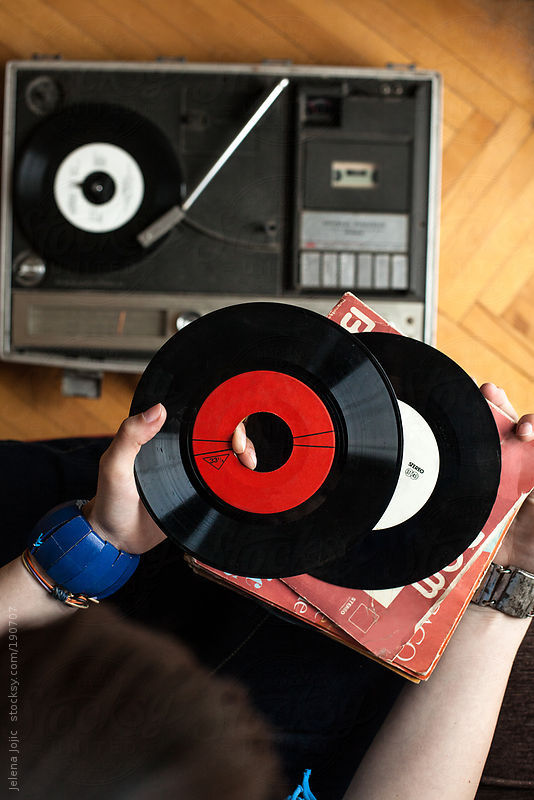 In those days when I reached maturity in musical terms - we were still listening to records - listening to music was something different from what exists today. For example, if you didn’t like playing music, you had to get out of the chair, go to the player, carefully raise the tonearm and advance the needle to the next track. It was necessary to make efforts to save yourself from listening to three minutes of bad music. Only the most terrible songs were worth all of these switching gestures.
In those days when I reached maturity in musical terms - we were still listening to records - listening to music was something different from what exists today. For example, if you didn’t like playing music, you had to get out of the chair, go to the player, carefully raise the tonearm and advance the needle to the next track. It was necessary to make efforts to save yourself from listening to three minutes of bad music. Only the most terrible songs were worth all of these switching gestures.
Today, with our trendy iPhones and cloud music subscription services, it’s no problem to rewind an unloving or boring track. Just press the button and you listen to another song. Now the Skip button is an integral part of the whole process of enjoying music. Don't like the song? Skip it. Never heard a song? Skip it. Just recently listened to this song? Skip it. Skipping plays a role even in the way we pay for music. In most interactive music services, to get complete freedom and the right to skip any song, you need to have the status of a Premium subscriber, otherwise you will be limited to about 5-6 passes per hour.
I was wondering how people use the Skip button, so I spent a lot of time studying the statistics of how Skip is applied in detail. For this research, I plunged into Spotify, where the guys built an amazing infrastructure for a huge amount of information, with which it is easy to get an idea of billions of music tracks. I studied billions of playlists of millions of unique listeners from around the world.
Here are some numbers. First, let's take a look at how often a song is skipped during the first five seconds of playback. I call it quick passes. The likelihood that the song will be promoted within the first five seconds reaches a staggering 24.14% . Almost a quarter of all songs rewind in the first five seconds. The likelihood that the song will be rewound within the first thirty seconds reaches 35.05% . The probability that a song will be skipped before it ends is amazingly high - 48.6%. That is, the chances that the song will be listened to the end are almost 50/50 .
The following chart shows skip averages for millions of listeners and billions of plays. The chart shows a sharp decrease in the number of listeners at the beginning of the track, when most of them decide whether to rewind the song. Then comes a slower but more stable decline in the number of listeners, until we reach the end of the song, where about 50% of the listeners remain. The following chart shows the average skip values for the first 60 seconds of the composition. It can be seen that most gaps occur during the first 20 seconds, after which the level drops, but does not disappear to the end. We can also calculate the overall level of skips for one listener. That is, the average number of passes per listener for one hour.
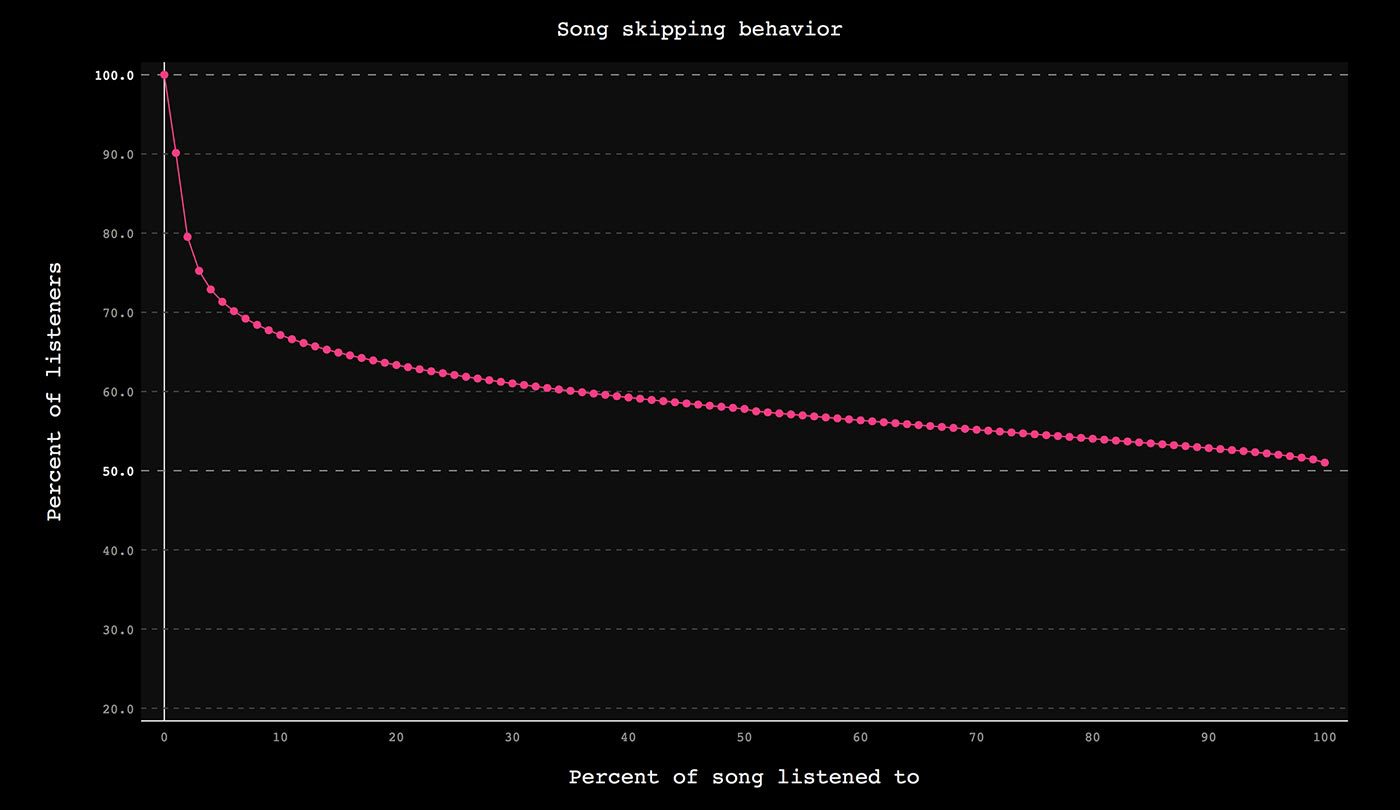
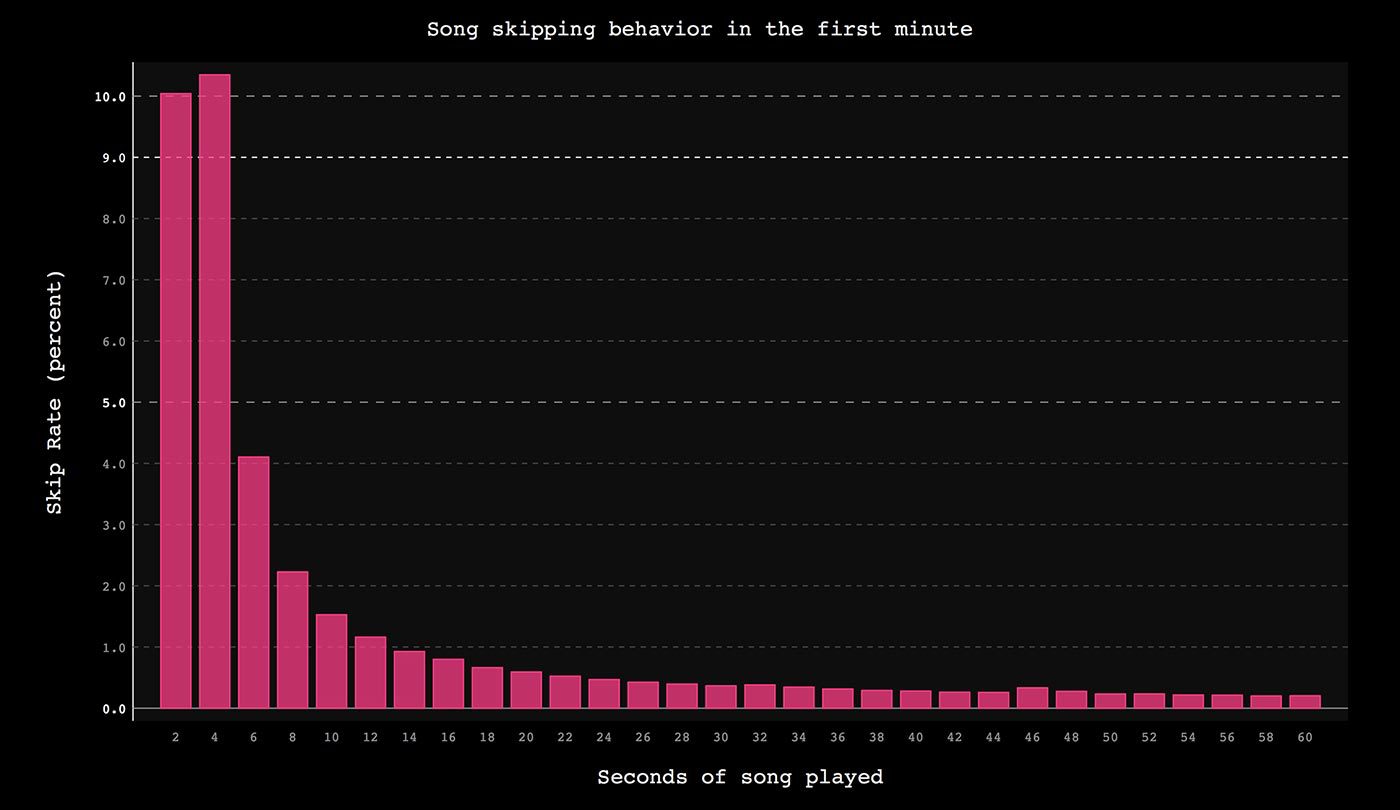
Average listener / skips per hour - 14.65
On average, the listener skips once every four minutes. This is really a lot.
Who rewinds songs all the time? Is it true that different listeners rewind music in different ways? Let's get a look.
The pass rate for female students is 45.23%.
Apparently, almost nothing depends on gender.
The pass rate on the mobile phone is 51.1%
When we are at the computer, we usually listen to music longer and rewind less, but on the mobile device we are more involved in the process of interacting with our music.
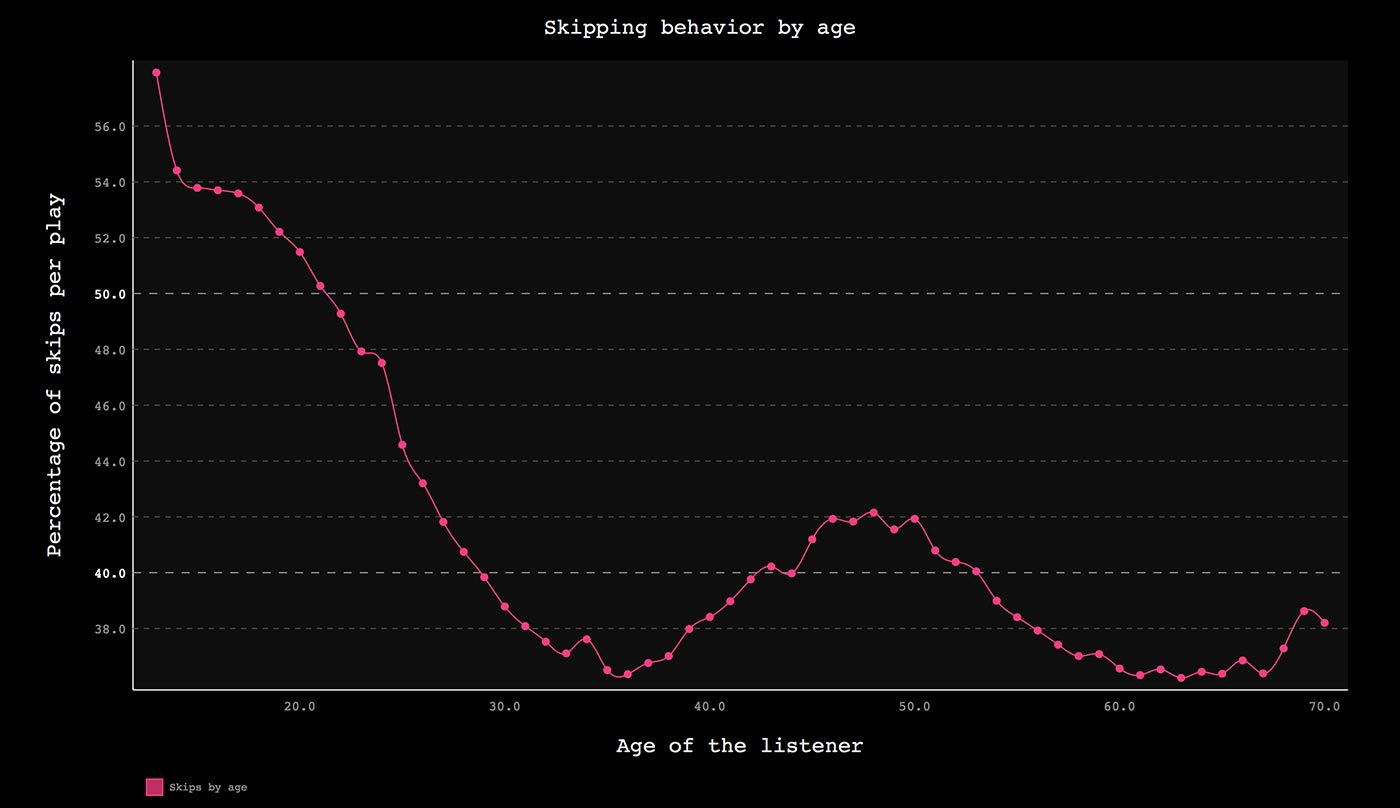
This chart reflects the level of skips relative to the listener age indicator. She shows that young students skip most of all - more than 50%. With age, this level decreases, reaching its lowest point at about 35%. It is interesting that the level of omissions starts growing again in people who are well over 40 or just over 50. I have a couple of ideas about why this could happen. The first theory is related to how much free time a person has. Teenagers rewind more because they have more options for editing their music stream, while 30-year-olds, with their families and endless work, cannot devote so much time to music players. The second theory proposed by Spotify analyst Chris Tynan explains this by
The following diagram shows the features of skipping songs for one day. To create this diagram, I studied the behavior in the field of listening to the music of the British (who are very conveniently located in the same time zone) for several weeks. The diagram informs that the level of skips is minimal when people pay the least attention to music, that is, during sleep or work. The figures peak in the morning, when people start the day and get ready for work, and also at the end of the day when they return home or chat with friends. The diagram shows when people pay special attention to careful monitoring of their musical environment.
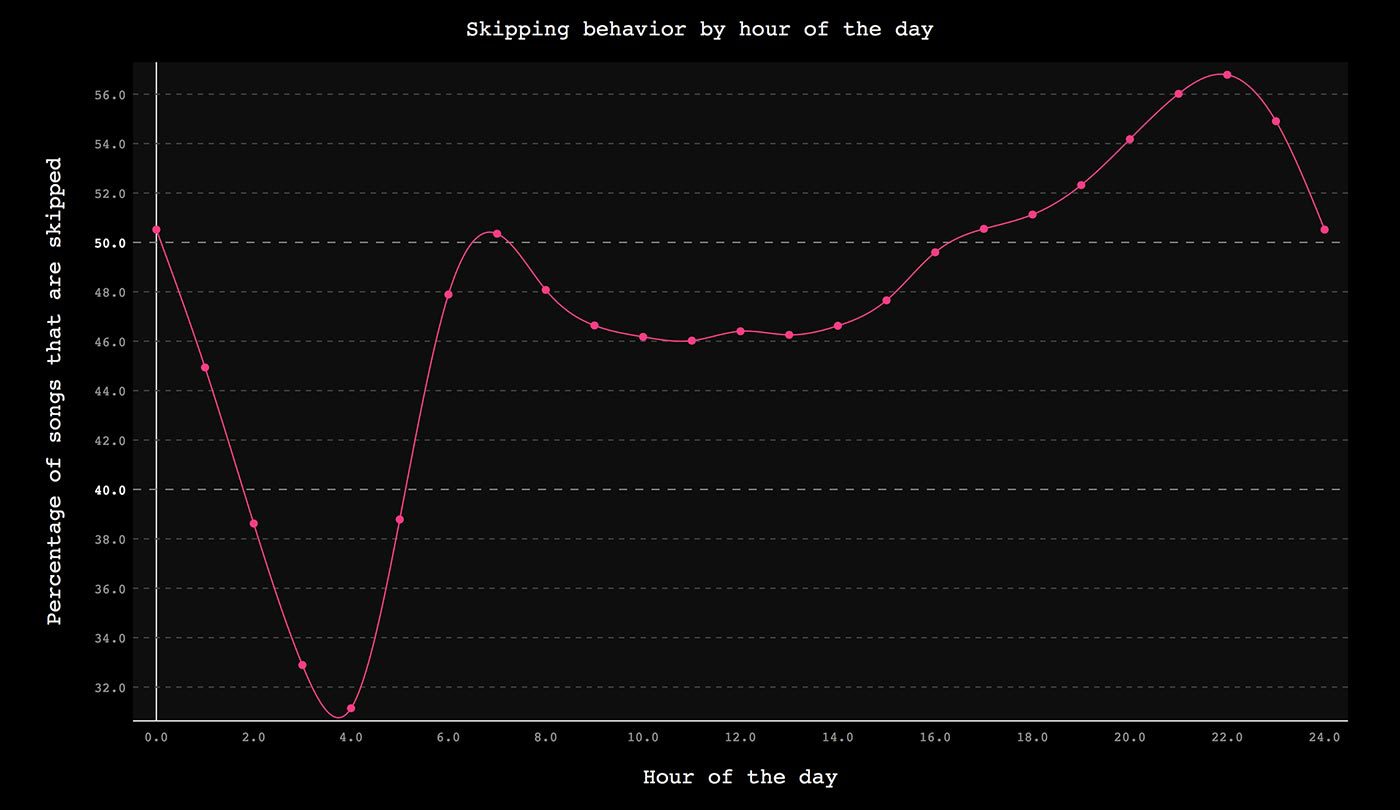
In the following diagram, the level of skips is intertwined with the average value by the number of reproductions. It is interesting that the differences in the number of skips do not affect when they listen to music the most. The number of reproductions stably holds and even grows by the end of the day. While the number of skips is constantly changing.
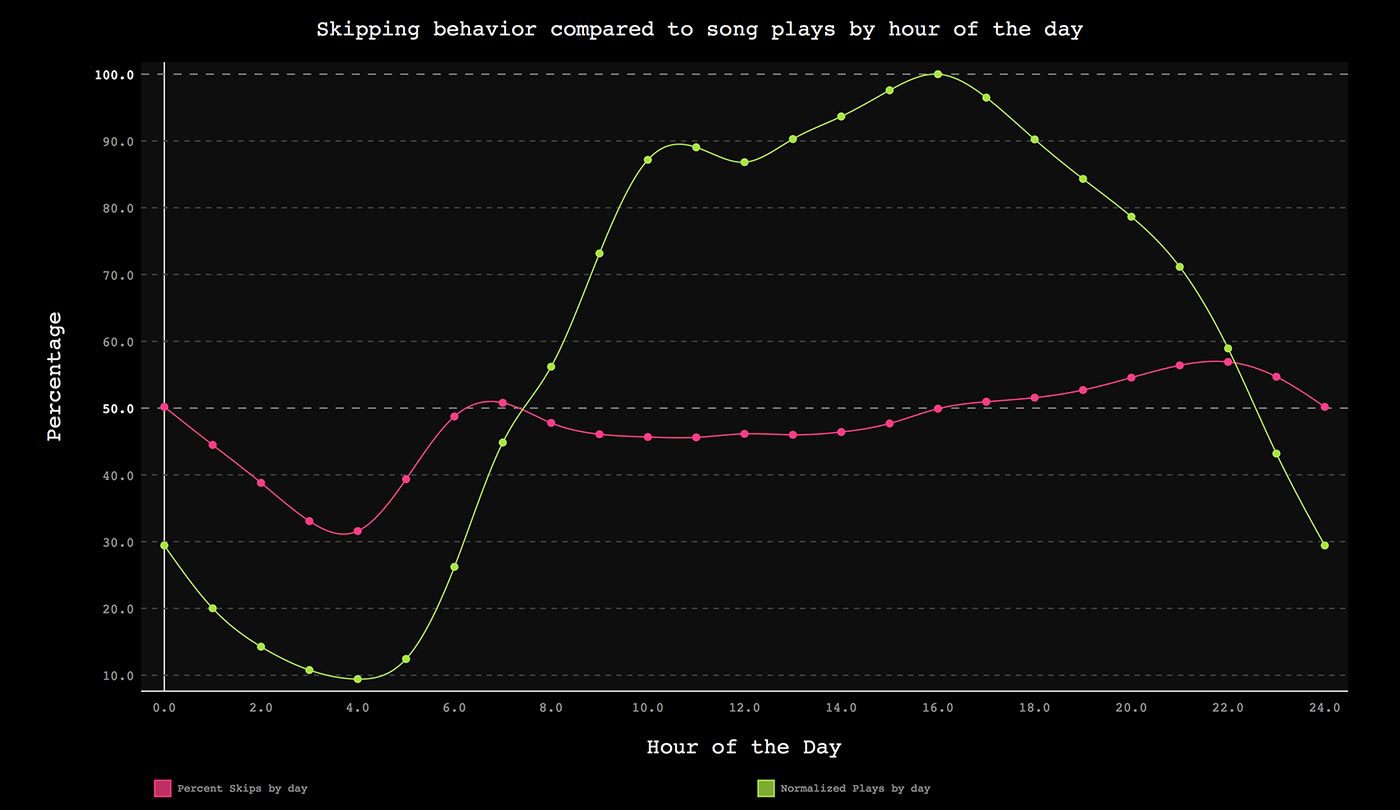
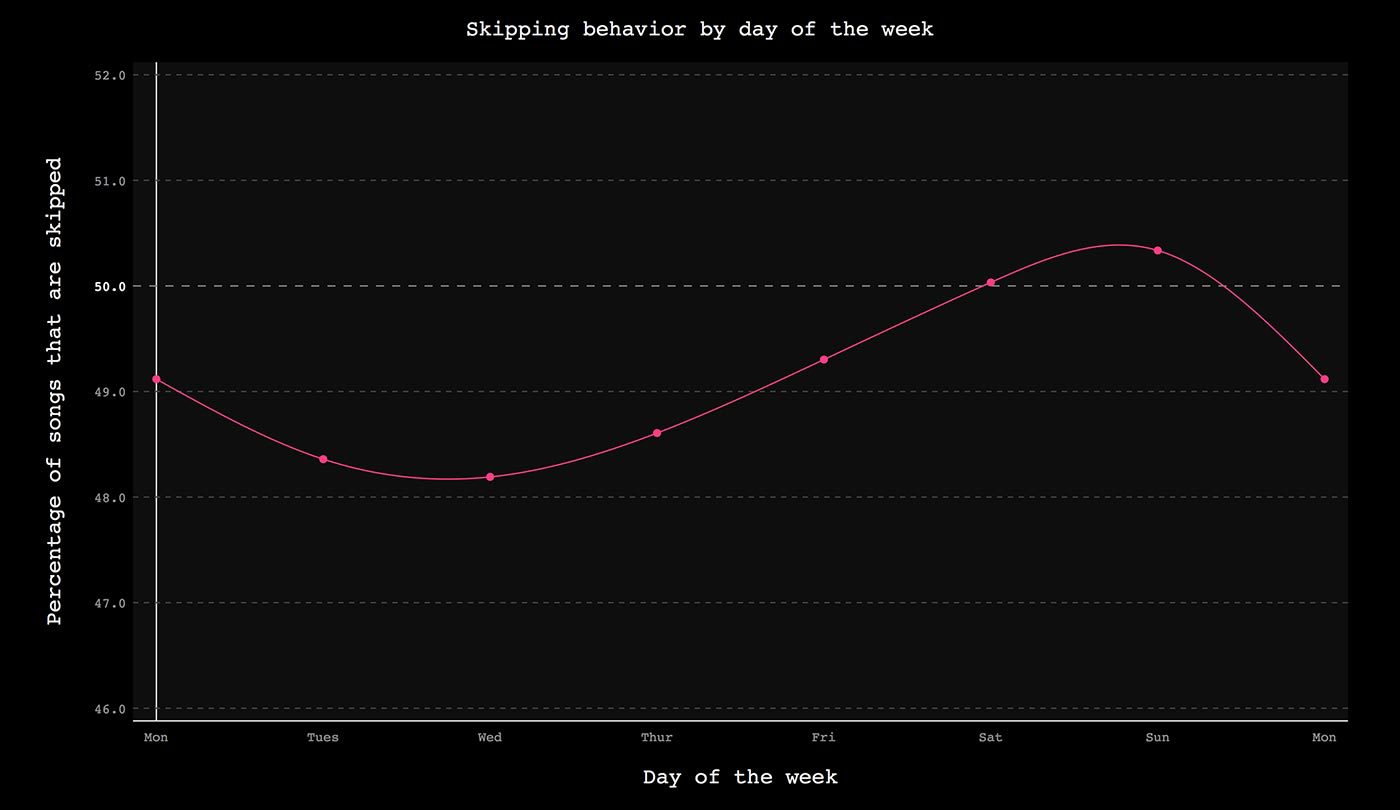
This chart shows the average skip level by day of the week. Demonstrating again that he is taller on weekends when people have free time to follow music and rewind bad tracks.
The skip button really changed the way we listen to music. She plays an important role in our interaction with her musical environment. When we are more involved in music, we make more passes, and when music only serves as a backdrop, when, for example, we work or relax, we rewind much less often. When we have more free time, for example in youth, or on weekends, or when we return home from work, we skip more tracks. Because it is at this time that we pay more attention to music. Personally, I was very surprised how often we tend to skip. On average, we skip every second song we hear.
Gaps have become an integral part of how we consume music. Therefore, it is not surprising that “unlimited passes” have become the feature that makes people sign up for a Premium account. This may also be the reason why people switch from one service to another when the first does not provide the possibility of unlimited passes even on a Premium subscription.
At spring Yandex Tolstoy Camp we launched a music service for personal selection of music. Thanks to the knowledge we have learned to constantly conduct experiments. With skips as well. We measure all the actions of our listeners, and we were able to understand the difference between listening patterns during the first and subsequent sessions. New users almost always differ in their behavior from users who returned for a new portion of music. More precisely: on the first day of acquaintance with the service, the user wants to make sure that the music is selected relevantly. For this, people boil a lot. Up to 95% of tracks in the first session, people listen for less than 5 seconds. Users look at covers, try to understand what kind of links these tracks appeared in the playlist, and decide whether they need a service or not. As a rule, these are 20-60 skips. If the matching mechanism is relevant, then people will come back. In our case, it is 28% on the second day and 9% on the thirtieth day. Summary: in all sessions after the first, people skip much less often.
Our most popular case is calm music (great for work), and those who skipped tracks on the first day, for the most part, change their approach to listening in the following days. Many just turn on the music and switch the tab. Then they listen to music in the background, which means they skip much less often. This fully confirms Paul’s conclusions that during work people tend to “disconnect” from music, it is perceived as a smooth background, if chosen correctly. You can learn more about comparing skips with likes in our blog.
When we limited the number of skips on the first day, we saw a huge dump of users after notification that the skips were over and had to be paid. Moreover, user returns have also plummeted downward.
Conclusion
You can not limit people to want to check the value of the service. Moreover, one cannot ask for money at this stage. As a result, we removed the restriction, as people lost the desire to use a service that they did not have time to understand. The conversion to payment has grown within the margin of error. There was no multiple increase or decrease in conversion.
Now we are thinking of conducting the same experiment with skip restrictions, but in the third or fifth session, that is, when the listener has already figured out why he needs our service. Taking this opportunity, I would like to ask you, how do you feel about this kind of mechanics?
Suppose you have already seen that the service plays music that is relevant enough for you and decided to return, but you are suddenly asked to pay for a subscription after the 10th skip per hour. How do you feel about this?
Try to remember how many times you clicked the Skip button today?
The Skip track button is almost everywhere we get audio content. It is so familiar that we can easily recognize it even in complex forms. Skip has become a daily occurrence for a modern culture of music consumption. But how deep is it rooted? Let's try a peek.

In this research article, you'll learn about people's behavior when it comes to skipping music. You will learn how often people skip music, whether demographic data influence people's habits of skipping music, which artists and genres most or less encourage you to click the Skip button, and much more.
The research was conducted by the development managerEchonest , his team has been analyzing music for an impressive number of parameters for about ten years. Now Echonest become a new division of Spotify .
 In those days when I reached maturity in musical terms - we were still listening to records - listening to music was something different from what exists today. For example, if you didn’t like playing music, you had to get out of the chair, go to the player, carefully raise the tonearm and advance the needle to the next track. It was necessary to make efforts to save yourself from listening to three minutes of bad music. Only the most terrible songs were worth all of these switching gestures.
In those days when I reached maturity in musical terms - we were still listening to records - listening to music was something different from what exists today. For example, if you didn’t like playing music, you had to get out of the chair, go to the player, carefully raise the tonearm and advance the needle to the next track. It was necessary to make efforts to save yourself from listening to three minutes of bad music. Only the most terrible songs were worth all of these switching gestures.Today, with our trendy iPhones and cloud music subscription services, it’s no problem to rewind an unloving or boring track. Just press the button and you listen to another song. Now the Skip button is an integral part of the whole process of enjoying music. Don't like the song? Skip it. Never heard a song? Skip it. Just recently listened to this song? Skip it. Skipping plays a role even in the way we pay for music. In most interactive music services, to get complete freedom and the right to skip any song, you need to have the status of a Premium subscriber, otherwise you will be limited to about 5-6 passes per hour.
I was wondering how people use the Skip button, so I spent a lot of time studying the statistics of how Skip is applied in detail. For this research, I plunged into Spotify, where the guys built an amazing infrastructure for a huge amount of information, with which it is easy to get an idea of billions of music tracks. I studied billions of playlists of millions of unique listeners from around the world.
What is a Skip?
For this study, I defined a skip as any listener switching a song before it ended. This can be either directly pressing the “Skip” button, or the intention to find another song, or clicking on a specific song in the playlist while the previous one is still playing. Whatever the reason, if a person does not listen to the song to the end, I call it Skip.How often do people skip?
The first and main question that needs to be answered: how often do people click the Skip button? What role do gaps play in our listening to music, given how easy it is to skip now? Answer: A huge role!Here are some numbers. First, let's take a look at how often a song is skipped during the first five seconds of playback. I call it quick passes. The likelihood that the song will be promoted within the first five seconds reaches a staggering 24.14% . Almost a quarter of all songs rewind in the first five seconds. The likelihood that the song will be rewound within the first thirty seconds reaches 35.05% . The probability that a song will be skipped before it ends is amazingly high - 48.6%. That is, the chances that the song will be listened to the end are almost 50/50 .
| Skipped over | Probability |
| First 5 seconds | 24.14% |
| First 10 seconds | 28.97% |
| First 30 seconds | 35.05% |
| Until the end of the song | 48.60% |
The following chart shows skip averages for millions of listeners and billions of plays. The chart shows a sharp decrease in the number of listeners at the beginning of the track, when most of them decide whether to rewind the song. Then comes a slower but more stable decline in the number of listeners, until we reach the end of the song, where about 50% of the listeners remain. The following chart shows the average skip values for the first 60 seconds of the composition. It can be seen that most gaps occur during the first 20 seconds, after which the level drops, but does not disappear to the end. We can also calculate the overall level of skips for one listener. That is, the average number of passes per listener for one hour.


Average listener / skips per hour - 14.65
On average, the listener skips once every four minutes. This is really a lot.
Who rewinds songs all the time? Is it true that different listeners rewind music in different ways? Let's get a look.
Gender characteristics
The pass rate for male students is 44.74%.The pass rate for female students is 45.23%.
Apparently, almost nothing depends on gender.
Based on platform
The pass rate on the computer is 40.1%The pass rate on the mobile phone is 51.1%
When we are at the computer, we usually listen to music longer and rewind less, but on the mobile device we are more involved in the process of interacting with our music.
By age

This chart reflects the level of skips relative to the listener age indicator. She shows that young students skip most of all - more than 50%. With age, this level decreases, reaching its lowest point at about 35%. It is interesting that the level of omissions starts growing again in people who are well over 40 or just over 50. I have a couple of ideas about why this could happen. The first theory is related to how much free time a person has. Teenagers rewind more because they have more options for editing their music stream, while 30-year-olds, with their families and endless work, cannot devote so much time to music players. The second theory proposed by Spotify analyst Chris Tynan explains this by
When do people rewind most?
The following diagram shows the features of skipping songs for one day. To create this diagram, I studied the behavior in the field of listening to the music of the British (who are very conveniently located in the same time zone) for several weeks. The diagram informs that the level of skips is minimal when people pay the least attention to music, that is, during sleep or work. The figures peak in the morning, when people start the day and get ready for work, and also at the end of the day when they return home or chat with friends. The diagram shows when people pay special attention to careful monitoring of their musical environment.

In the following diagram, the level of skips is intertwined with the average value by the number of reproductions. It is interesting that the differences in the number of skips do not affect when they listen to music the most. The number of reproductions stably holds and even grows by the end of the day. While the number of skips is constantly changing.

Day skip scheme

This chart shows the average skip level by day of the week. Demonstrating again that he is taller on weekends when people have free time to follow music and rewind bad tracks.
Conclusion
The skip button really changed the way we listen to music. She plays an important role in our interaction with her musical environment. When we are more involved in music, we make more passes, and when music only serves as a backdrop, when, for example, we work or relax, we rewind much less often. When we have more free time, for example in youth, or on weekends, or when we return home from work, we skip more tracks. Because it is at this time that we pay more attention to music. Personally, I was very surprised how often we tend to skip. On average, we skip every second song we hear.
Gaps have become an integral part of how we consume music. Therefore, it is not surprising that “unlimited passes” have become the feature that makes people sign up for a Premium account. This may also be the reason why people switch from one service to another when the first does not provide the possibility of unlimited passes even on a Premium subscription.
An experiment from the author of the translation
At spring Yandex Tolstoy Camp we launched a music service for personal selection of music. Thanks to the knowledge we have learned to constantly conduct experiments. With skips as well. We measure all the actions of our listeners, and we were able to understand the difference between listening patterns during the first and subsequent sessions. New users almost always differ in their behavior from users who returned for a new portion of music. More precisely: on the first day of acquaintance with the service, the user wants to make sure that the music is selected relevantly. For this, people boil a lot. Up to 95% of tracks in the first session, people listen for less than 5 seconds. Users look at covers, try to understand what kind of links these tracks appeared in the playlist, and decide whether they need a service or not. As a rule, these are 20-60 skips. If the matching mechanism is relevant, then people will come back. In our case, it is 28% on the second day and 9% on the thirtieth day. Summary: in all sessions after the first, people skip much less often.
Our most popular case is calm music (great for work), and those who skipped tracks on the first day, for the most part, change their approach to listening in the following days. Many just turn on the music and switch the tab. Then they listen to music in the background, which means they skip much less often. This fully confirms Paul’s conclusions that during work people tend to “disconnect” from music, it is perceived as a smooth background, if chosen correctly. You can learn more about comparing skips with likes in our blog.
When we limited the number of skips on the first day, we saw a huge dump of users after notification that the skips were over and had to be paid. Moreover, user returns have also plummeted downward.
Conclusion
You can not limit people to want to check the value of the service. Moreover, one cannot ask for money at this stage. As a result, we removed the restriction, as people lost the desire to use a service that they did not have time to understand. The conversion to payment has grown within the margin of error. There was no multiple increase or decrease in conversion.
Now we are thinking of conducting the same experiment with skip restrictions, but in the third or fifth session, that is, when the listener has already figured out why he needs our service. Taking this opportunity, I would like to ask you, how do you feel about this kind of mechanics?
Suppose you have already seen that the service plays music that is relevant enough for you and decided to return, but you are suddenly asked to pay for a subscription after the 10th skip per hour. How do you feel about this?
Only registered users can participate in the survey. Please come in.
Skip, or not skip. That's the poll
- 6% I like to skip a lot. If the music is good, I’m ready to pay a subscription; 72
- 11.8% The essence of the restrictions is clear to me, but I am not ready to pay for it; 141
- 14.1% I think these restrictions are slippery; 169
- 46.5% Any restrictions of this kind are unpleasant to me; if I see it, I will close the site and will not return; 554
- 20.4% I rarely switch tracks if the music is good. I don’t care about these restrictions; 243
- 1% Other. I’ll tell you in the comments. 12
